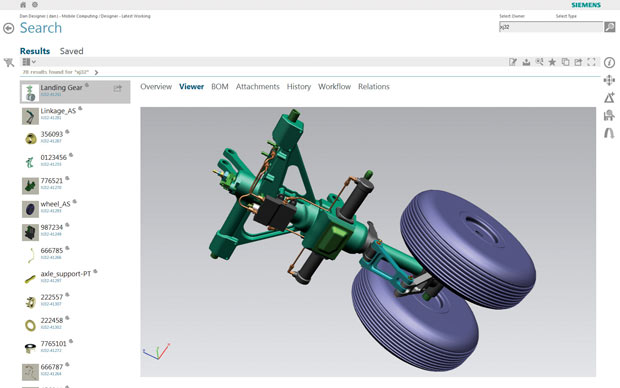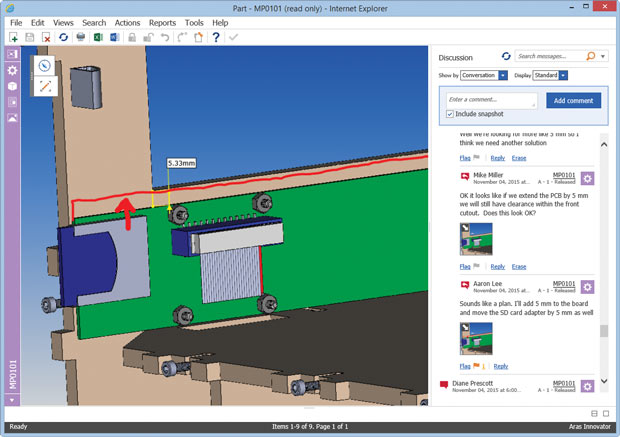
The Active Workspace main user interface lets users visualize the model while sporting tabs for BOM, attachments and other assemblies. Image courtesy of Siemens PLM Software.
March 1, 2016
 Visual collaboration lets users mock up models for easier cross-discipline collaboration. Image courtesy of Aras.
Visual collaboration lets users mock up models for easier cross-discipline collaboration. Image courtesy of Aras.Collaboration has always made the business world go round. And electronic tools for sharing information—everything from email to videoconferencing to PDF documents—have advanced the art of sharing data exponentially in the past 20 years. Now, in the age of digital transformation of manufacturing enterprises, collaboration is becoming turbocharged. Next-generation product lifecycle management (PLM) and other enterprise systems are enabling advanced collaboration.
The dirty little secret: The sharing of data related to areas such as requirements management, project management, quality and production is still done largely via spreadsheets. Communication is still spread across multiple largely disconnected channels and tools, resulting in barriers between different disciplines (including mechanical, electronics and software) and business functions such as engineering, manufacturing, quality, testing and procurement. These barriers are particularly evident when attempting to collaborate across the extended enterprise with suppliers and customers as is required in today’s business environment.
Top-name PLM vendors including Siemens, Dassault Systèmes and PTC are boosting their collaborative capabilities to ensure engineering can share data effectively with other groups, says to Marc Halpern, vice president of Research at Gartner.
For example, Siemens provides change management and bill of material (BOM) management capabilities via Teamcenter, according to Chris Pattioni, marketing director for Siemens. “With Active Workspace in Teamcenter, you now have the ability to assess the impact of a change, how it impacts data, people and processes in terms of cost, timing and commitments,” he says.
Different parts of the enterprise including design, engineering and procurement, typically maintain their own representation of the BOM. With all of those disparate representations, it can be difficult to understand what is out of scope or out of date. Teamcenter provides a single product definition for all who interact with the BOM, says Pattioni, eliminating the need for standalone spreadsheets and systems.
 The Active Workspace main user interface lets users visualize the model while sporting tabs for BOM, attachments and other assemblies. Image courtesy of Siemens PLM Software.
The Active Workspace main user interface lets users visualize the model while sporting tabs for BOM, attachments and other assemblies. Image courtesy of Siemens PLM Software.Aras’ Innovator has “visual collaboration” capability embedded in its PLM platform, allowing secure threaded discussions and for view and markup of assorted formats including 3D, 2D, PDF and Microsoft Office.
“This is about taking key processes in the manufacturing organization and making sure they are digital from end to end and that all of the people involved can get access to the information they need in a consistent manner,” says Doug Macdonald, product marketing director for Aras.
Most manufacturers have mastered electronic collaboration for processes such as the management of CAD information. Macdonald calls this realm the “science of engineering.” But many other cross-functional processes such as requirements management, quality and BOM management are fragmented and run on spreadsheets. He calls this area the “business of engineering.”
“That’s where we are starting to solve the collaboration problem. Everyone in the enterprise needs access to all of this product information. Each department needs to be able to define and support their processes, and get everyone on the same page,” he says.
PLM analyst Monica Schnitger cites warranty information as an area that could be transformed via better collaboration. Assume a car company is seeing a lot of claims for a certain issue on a particular model. “What other models might be using that same component? If they could access that information easily, they could get ahead of that situation and give that information to dealerships and the repair shop network,” says Schnitger, president of Schnitger Corp.
“A lot of companies have not connected the dots,” she says. “The information is there, but it is not connected such that people can access it and take actions.” Next-generation PLM systems, product innovation platforms, design optimization tools and collaboration hubs all seek to enable collaboration.
Collaboration By Any Other Name
CNH Industrial/Reman remakes parts used in agricultural equipment at its 300-person Springfield, MO, plant. As a small unit of a large conglomerate, CNH has not yet invested in major enterprise systems such as ERP (enterprise resource planning) or MRP (materials requirements panning). Four years ago, it implemented Aras Innovator for PLM. According to project engineer Collin Fagan, the need to share information more easily was the top driver for the purchase.
“We were managing our creation of parts from inception to launch by email and spreadsheet,” says Fagan. “Parts would get stalled in different places and if someone wasn’t at the meeting, you lost all visibility.” Now, with Aras Innovator, “We can track a part from the time the product development team decides to do it to materials management, manufacturing, marketing, field support, etc. Anyone who has access can instantly see where a part is at any time,” he says.
CNH has seen major savings of time and money. Fagan estimates use of the tool has eliminated 20 to 25 hours of meeting preparation every week, with instant answers accessible for the 125 staff and managers who use the system.
“Management can quickly see who has ownership of a process activity. This helps them identify staffing issues versus process issues,” says Fagan. Managers can see the flow of parts through the pipeline at the weekly meeting, quickly identifying choke points and allowing for immediate corrective action. Under the old, spreadsheet-based system, problems may not have even been identified. Now, the users can see what other departments are doing without having to request data.
Cloud-based PLM is indeed enabling greater collaboration, says Halpern. “A lot of new PLM applications are being built to run on the cloud and existing apps are being rewritten for the cloud,” he notes. The big advantage: Regardless of device and location, you can collaborate with growing bandwidth, greater accessibility and increasing performance.
Design Optimization
In addition to PLM, design optimization suites are getting in on the action, promoting better multi-disciplinary collaboration. ESTECO makes design optimization software that integrates simulation data with other enterprise systems in order to be part of the enterprise product development process. (Editor’s note: For more on ESTECO’s workflow optimization concept, see page 8.)
Users can set the parameters on the ESTECO SOMO collaboration framework to control for different variables, says Matteo Nicolich, enterprise solution product manager for ESTECO.
“The SOMO system generates information about the behavior of the product in different situations so you can monitor its performance,” says Nicolich. SOMO generates the performance data and stores it where it can be mined.
Engineers are looking to multi-disciplinary process optimization as a way to speed up the design process, capturing data to be shared and reused rather than being left siloed, adds Nicolich.
“You can look at a component from different angles and points of view. You can have a structural analysis, a thermal analysis, an electrical analysis of the same component. Each of these requires a different knowledge base. They need to reach a point where they can track and ensure that everything works together,” says Nicolich. “That’s where our tool fits.”
The demand for next-generation collaboration tools comes from gaps that remain post-PLM implementation, says Macdonald. Manufacturers still have process bottlenecks, miscommunication and lack of visibility. “They need a much more integrated approach” spanning manufacturing, engineering, supplier management, product support, quality, product development and product management, he says.
Traditionally, the IT organization working closely with the engineering department has driven the purchase of PLM. Now, with collaboration paramount, engineering is beginning to lead the selection process. “How well your supply chain works together is becoming a key differentiator,” says Halpern.
More Info
Subscribe to our FREE magazine, FREE email newsletters or both!
About the Author
Lauren Gibbons Paul is a Boston-based freelance writer. Contact her via .(JavaScript must be enabled to view this email address).
Follow DERelated Topics






